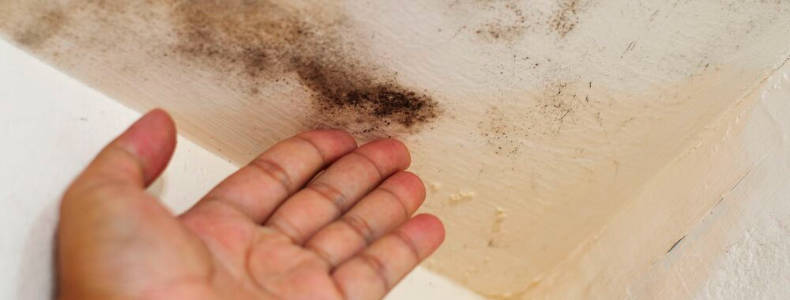We’re big believers in Murphy’s Law here at Gutter and Roof Repairs; chances are if you’re roof is going to spring a leak it’s going to be when there’s lots of rain expected over the next few days, or when there’s a large storm and many other Brisbane homes need to get their roofs repaired.
If you’ve discovered your roof is leaking, it’s important that you at least try to stop the leak temporarily until a professional Brisbane roof repairer can get out and take a good look over your roof. There are several things you can do to temporarily stop the leaks in your roof, but it’s important that you don’t further damage your roof in the process.
How to Tell if You’ve Got a Leak in Your Roof
There are lots of different ways that leaks in your roof can present themselves – from a damp section in your ceiling after some rain, through to water running down your internal walls during a storm. Here are some ways to tell if you might have an issue with your roof.
Stains, Mould or Discolouration
If you find a circular stain on your ceiling, it’s a sign that water is leaking through your roof. Stains aren’t always visible and can sometimes be hard to spot. If the stain is new, growing in size or looks moist or is moist to touch (try putting a piece of paper towel up to it to see if it becomes damp) that’s usually a surefire sign you’ve got a leak of some sort.

Dripping
If there’s a drip or you can hear a drip, it’s not always automatically going to be your tap. Obviously this is hard to hear during rain or storms, but sometimes water can pool on your roof and cause drips to happen. Drips won’t always come from the ceiling either. Often water will drip and make its way down walls causing moisture trails. Sometimes these drips or leaks can be caused by a buildup in water from a blockage or a tile that’s moved.
Spots on the Eaves
Water doesn’t always make its way inside. Sometimes you need to do an external check of your home to make sure water isn’t getting into your eaves and making its way down the outside of your home. If there’s a leak that’s leading to water dripping down the outside of your home, it’s likely to be in an area that you don’t check all that often so it’s a good idea to check everywhere.
Debris in Your Downpipes
If you’re seeing little parts of concrete or chips, flakes or sections of tiles the same colour as your roof tiles, there’s a good chance bits of your roof might be missing and causing your roof to leak.
Now that you know the tell tale roof leak signs to look for, here’s what you can do about it.
How to Find a Leak in Your Roof
Obviously, the best thing you can do is call a professional roof repair and replacement company to come out to your home, evaluate the issue quickly for you and provide a course of action that will fix your roof and guarantee there’s no more leaks.
Note: If you’re not confident in your handyman skills or aren’t good with heights, it’s a always better to call a professional as you may cause more damage than you fix if you get something wrong.
Mould
If you get into your roof cavity and have a look around you want to keep an eye out for mould in your roof. Where there’s moisture, there’s usually mould.
Rotting Wood
Take a close look at the beams, cross beams and supports inside your roof. If there are signs of rot or the beams start to crumble, peel or come away easily when poked with a screwdriver, there’s a good chance water is getting on that wood and causing issues.

Light
Get up into your roof during the day and look for any large spots or unusual patterns of light. It’s normal for some light to make its way through (particularly if you have a tiled roof) so you want to look out for any areas where there’s more light coming through than usual or a section that doesn’t look like all the other patterns of light making their way through your roof.
Tips for the Hard-To-Find Leak
Sometimes leaks are pesky things and they’re incredibly difficult to find. They don’t always leave evidence or traces where water comes through the roof so tracking them down (particularly if it’s a few days after it rains) can be somewhat tricky. If you’re having issues finding a leak in your roof but you’re sure there is one, it’s time to employ the help of someone that doesn’t mind heights and hoses.
If you start slow and soak the area on the roof directly above the leak, you may be able to see water coming in from the roof. If you can’t see water directly coming in from the area you suspect the leak may be, keep the water on for a good 15-20 minutes as leaks can sometimes take a while to appear.
If after 20 minutes or so the leak still hasn’t presented itself, test different roof areas at intervals of 15 minutes each. If after all this time you’re still not seeing the leak, it might be time to start peaking under tiles to see if there’s water buildup in particular areas.
What to Do Once You’ve Found the Leak
Once you’ve found the leak, it all really depends on the severity of the issue that will determine the next step. If it’s from a cracked tile, and you have spare tiles lying around, simply replacing your tile may fix the issue.
- If you notice that the seals on your metal roofing screws have disintegrated leaving a space for water to get in, replacing these may fix your issue.
- If you happen to notice that flashing or gutters are damaged or broken, they may be able to be fixed with some silicon or need a complete replacement depending on the severity of the issue.
If you don’t feel comfortable fixing your own roof or need major repairs, Gutter and Roof Repairs can provide an expert roof inspection and quote.



